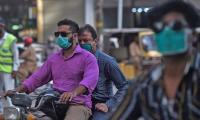It took Indian Supreme Court almost four years to take up a clutch of identical petitions vis a vis revocation of Article 370 of the Indian constitution that had given special status to India’s only Muslim-majority state of Jammu and Kashmir.
The five-judge constitutional bench that includes Supreme Court Chief Justice Dhananjaya Yeshwant Chandrachud is simultaneously hearing a series of petitions challenging the special status granted to the region after India annexed the Muslim majority state illegally after the partition of the subcontinent in 1947. The abrogation of Article 370 split the region into two federal territories - Ladakh and Jammu-Kashmir, both ruled directly by Narendra Modi led government without a legislature of their own. The immediate implications of the region had been terrible, the people of Kashmir since August 2019 have been ruled by bureaucrats with no democratic credentials and it also lost its constitution, its flag and criminal code.
India initiated the process of integrating IIOJK into rest of the country through changes in administrative setup that too enacted without public input, which could have only been possible through the legislative assembly of the region that ceased to operate since 2016 after the then government of Mehbooba Mufti collapsed. Apart from the apprehensions raised by people of Kashmir regarding autonomy issues, the real issue is that the annexation of IIOJK through Reorganization Act-2019 by New Delhi on August 5, 2019, is a clear violation of international laws particularly United Nations Security Council (UNSC) resolutions.
Established by UNSC, United Nations Commission for India and Pakistan (UNCIP), on , August 13, 1948, and January 5, 1949, demanded the right to self-determination for the people of IIOJK through a plebiscite governed by UN. However, it has been quite unfortunate that India used dilly-dallying tactics to avoid the plebiscite and continues its occupation of the territory despite the fact that UN appointed several plebiscite administrators for the purpose. Indian rulers led by Jawahr Lal Nehru manipulated a temporary link between IIOJK and rest of India through Article 370, a constitutional provision of the Indian constitution. Although it was deemed as a temporary deal until a solution to the dispute was to be found, but India hoodwinked the Kashmiri leaders like Sheikh Abdullah about the hollow autonomy through clauses like 370. Article 370 was later supplemented by Article 35A that provided a sense of security to the people of Kashmir over their land.
Although this was a temporary, transitional and provisional arrangement which none of the other Indian states enjoyed, Bharatiya Janata Party had on its agenda to snatch this very right from Kashmiris. BJP succeeded in ending the special status of IIOJK, unlawfully in 2019 but this illegal Indian act neither has a legal standing nor can it alter the disputed status of Jammu and Kashmir in the perspective of global laws. As the UNSC resolutions clearly state that its only the people of Jammu and Kashmir who will decide their future through a fair and free plebiscite. Apart from UNCIP resolutions, of August 13, 1948, and January 5, 1949, two UNSC resolutions (Resolutions number 91 of March 30, 1951, and Resolution number 122 of January 24, 1957) clearly state that neither legislative assemblies nor the occupying state (India) can change the status of the Jammu and Kashmir.
UNSC anticipated such a move and adopted the aforementioned resolutions, but India used the Sheikh Abdullah led National Conference as a main instrument to change the status of the state and make it part of Indian Union with the help of a manipulated resolution through IIOJK Constitutional Assembly. As Alastair Lamb pointed out on Page 190-191 in his book, ‘Kashmir: A Disputed Legacy 1846-1990’, that the Article 370 (originally 306-A), though was the brainchild of Nehru; nonetheless, it was drafted by Gopalaswami Ayyengar along with National Conference’s Sheikh Abdullah. However, through above-mentioned resolutions, UNSC put a limitation on the mandate of occupied territory’s constitutional assembly from taking any action to alter the status of IIOJK.
The UN resolutions clearly state, “The final disposition of the State of Jammu and Kashmir will be made in accordance with the will of the people expressed through the democratic method of a free and impartial plebiscite conducted under the auspices of the United Nations.” Indian government repealed Article 370 at a time when governor rule was imposed in the state and no elected government was in place. It was the prerogative of the Constituent Assembly of IIOJK that had adopted Article 370 to abrogate it, but BJP government in centre adamant to appease its vote bank and rob Kashmir of its autonomy, took this illegal step without the consent of the so-called elected government of occupied Kashmir.
In its historical verdict on October 16, 2015, the high court in Indian illegally occupied Jammu and Kashmir clearly ruled that: one; Jammu and Kashmir is not part of India, two; abrogation of Article 370 will not be able to change the special status of the territory, three, Article 370 cannot be repealed, abrogated or amended without the consent of Legislative Assembly of the territory and last but not the least India has no right to merge Jammu and Kashmir into its union. With such a clear mandate of the IIOJK’s high court, the Indian act of August 5, 2019, can clearly be termed as a violation of its own constitution.
As far as legal perspective is concerned, on August 5, 2019 after revocation of Article 370, IIOJK stood independent to take any lawful course of action about its future. It was Article 370 only that was a link between India and occupied Kashmir as that had the approval of the territory’s Legislative Assembly. So it can be rightly said that on 5 August 2019, India through massive deployment of 900,000 troops militarily reoccupied Jammu and Kashmir and clamped down a strict curfew that continued for months. All of this was done illegally to not only legalize the illegal, but to change the demography of the occupied territory through conversion of Muslim majority status of IIOJK into minority and declaring the ceasefire line between Pakistan and India as a permanent border.
Changing IIOJK’s demography
In order to further its toxic Hindutva ideology and alter the demography of IIOJK, Bharatiya Janata Party left no stone unturned and issued over 300,000 domicile certificates to non-Kashmiri Hindus from various parts of India which is a grave violation of Fourth Geneva Convention. Article 49(6) of Fourth Geneva Convention prohibits occupying power(s) to transfer its own population into the occupied territory. Indeed, this is yet another aspect, covered under the blatant human rights violation. Sub Article; Article (6) of the Fourth Geneva Convention deals with the protection of the civil population of occupied territory in emergency and wartime and Indian illegally occupied Jammu and Kashmir with an overwhelming presence of 900,000 troops is nothing but a war zone.
It seems India took a leaf out of Israel’s book which invited Jews from all over the world in 1948 to settle in Palestine. Besides strict restrictions, Jammu and Kashmir Reorganization Act-2019, formally imposed on October 31 2019, allowed New Delhi to introduce a new set of amendments to the laws which the Constituent Assembly of the state formulated before it was dissolved in 1957. Indian Home Ministry replaced or revoked over twenty-five laws in the occupied territory after the Adaptation of State Laws Order-2020.
Fourth Geneva Convention Prohibits Demographic Changes
The local civil population of any occupied territory is provided with sufficient protection under the fourth (4th) Geneva Convention-1949. Under Article 8(2)(b)(viii) of the 1998 ICC Statute, “[t]he transfer, directly or indirectly, by the Occupying Power of parts of its own civilian population into the territory it occupies” constitutes a war crime in international armed conflicts.
* Statute of the International Criminal Court, adopted by the UN Diplomatic Conference of Plenipotentiaries on the Establishment of an International Criminal Court, Rome, 17 July 1998, UN Doc. A/CONF.183/9, Article 8(2)(b)(viii).
A close analysis of Article 49 (6) of the Fourth Geneva Convention clearly postulates that transfer by an occupying power of its own population in the area it occupies and colonizes is strictly outlawed and banned. Article 49 (6) clearly stipulates that any occupying power has no right to deport or transfer parts of its own population into the region it occupies. The provisions of International Humanitarian Law (IHL) further augment this argument. IHL’s Rule 130 clearly conditions that “States may not deport or transfer parts of their own civilian population into a territory they occupy”.
India tried to bring legitimacy to its demographic changes in the occupied territory through Jammu and Kashmir Reorganization Act-2019 and Adaptation of State Laws Order-2020. This Indian bid is challengeable being illegal because India cannot legitimize an act which is illegitimate not only from its conception but to its implementation as well and is against international practices. India being an occupying power has no right whatsoever to legitimize an act that clashes with International Law, UNSC resolutions, Geneva Convention and agreements. And finally in a territory that legally does not belong to it, India cannot make laws for it.
The Way Forward
There are penalties and consequences for the states that violate the Fourth Geneva Convention-1949 and international law. The war crimes India is committing in occupied Kashmir fall under the ambit of violations of Geneva Convention particularly its Article 49. Whereas, Article 8 (2) (b) (viii) of the 1998 Rome Statute of the International Criminal Court (ICC) also considers any direct or indirect shifting and transfer of an occupying states’ own civilian population into the parts under its occupation as a war crime. Without any reprimand, India has been doing this for past over seven decades, and after 5 August 2019, it finds itself in complete authority to do so. But this cannot be left alone by the international community, such acts can be dealt under Article 146 and Article 147 as ‘a a grave breach of the Geneva Conventions and carries penal sanction.’ This is further supplemented by Article 85 (4) (a) of the 1977 Protocol I Additional to the Geneva Conventions. Article 1 Common to the four Geneva Conventions and Art. 86 of Protocol I Additional to the Geneva Conventions 1977; impose an obligation upon all High Contracting Parties to implement its provisions.
The right path now for smooth resolution of Kashmir dispute is to use stipulations of the Fourth Geneva Convention because under these provisions, India is under obligation to act upon Geneva Convention which is part of international law. As India has been intransigent in resolving the Kashmir dispute as per UN resolutions and international law, Pakistan must knock on the doors of the United Nations and the International Court of Justice (ICJ) about the latest developments in the occupied territory after 5 August 2019. As far as legal perspective of the issue if concerned, Pakistan stands at a higher pedestal over the Kashmir dispute. Pakistan should immediately approach ICJ and the UN seeking justice for Kashmiris; which should have been done soon after India unilaterally changed the status of the territory on August 5, 2019.
On the other hand as the Supreme Court of India has started hearing the petitions, we hope the truth about the illegality of J&K Reorganization Act and India’s actions will be exposed.
At a time when democracy and secularism are under attack in India and minorities are unsafe, the Supreme Court hearing on the unilateral abrogation of Article 370 is a significant event and let’s keep our fingers crossed as far as the final judgment of the Indian Supreme Court on the petitions challenging the J&K Reorganization Act are concerned.
Minister of State for Information Technology and Telecommunications Shaza Fatima Khawaja addresses a ceremony at a...
Minister for Law and Justice Azam Nazeer Tarar.— Facebook@SenAzamNazeerTarar/File Islamabad: Minister for Law and...
Senate Chairman and former Prime Minister Yousuf Raza Gilani addressing Iqra university's convocation ceremony on...
British High Commissioner to Pakistan Jane Marriott addresses at an event on November 13, 2024. —...
Federation of All Pakistan Universities Academic Staff Association President Dr Amjad Abbas Magsi. —...
Women check rice prices at a main wholesale market in Karachi. — AFP/FileIslamabad: Over 900 utility stores have...







